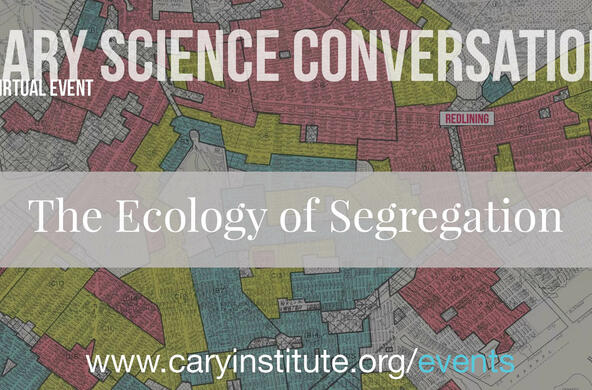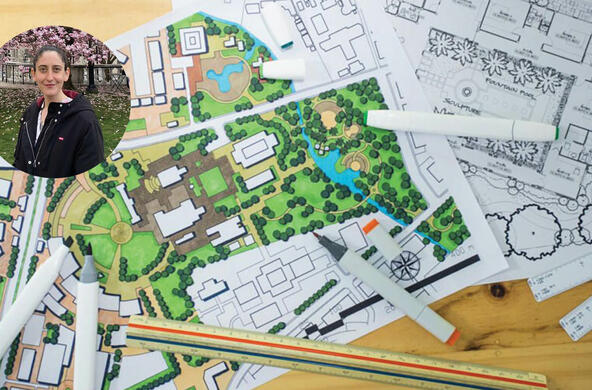Every July, for four years running, Shannon LaDeau inspected nine ceramic toilets sitting idly in a vacant lot behind a building, near a block of abandoned lots and houses on the edge of the West Baltimore neighborhood of Franklin Square. No, she is not weird. This was for science.
LaDeau's visits revealed that each of the nine toilets was reliably filled up with stale water, surrounded by overgrown foliage, and boxed in by litter and trash. What the average viewer saw was an eyesore; what LaDeau saw was the perfect breeding ground for Aedes albopictus, otherwise known as the Asian tiger mosquito, an invasive species that routinely annoys at your summer cookouts.
"It was a great mosquito habitat," says LaDeau, associate scientist of disease ecology at the New York-based Cary Institute of Ecosystem Studies. "It collected detritus and vegetation in a way that a pond might, and so it was a resource-rich place for juvenile mosquitoes to grow."
Not only was it a great mosquito habitat, but it was also a great example of the associations that exist within Baltimore neighborhoods between urban decay and residents' susceptibility to mosquito-borne diseases. Put simply: Areas of high vacancy and wild vegetation—the empty lots filled with overgrown grass and, more often than not, piles of trash—are also areas where there's an abundance of adult mosquitoes, the males who are necessary to keep reproducing and the females who bite and, sometimes, carry and transmit diseases like Zika.
In June, LaDeau and five fellow researchers published their findings of the socio-ecological factors supporting high population densities of the Asian tiger mosquito in Baltimore in the Journal of Medical Entomology. (Why Baltimore? Along with Phoenix, it's one of only two American cities part of a long-term ecological study established by the National Science Foundation.)
For three summers—2013 through 2015—LaDeau's team tracked 16 city blocks representing nearly 2,300 land parcels across five West Baltimore neighborhoods: Bolton Hill, Harlem Park, Union Square, Hollins Market, and Franklin Square. The neighborhoods represent a range of incomes: Bolton Hill, a mid-town neighborhood of grand three-story Victorian-style rowhouses, was the most affluent, while Harlem Park, just south of Freddie Gray's home neighborhood of Sandtown-Winchester, ranked at the bottom in terms of median household income. In general, many parts of West Baltimore struggle with high poverty—a legacy, in part, of the racial redlining practices that defined the shape of the modern city. In Harlem Park, there are more than 600 vacant buildings, according to Baltimore City government numbers. The unemployment rate is above 16 percent.
"Harlem Park, Franklin Square, and Union Square and Hollins Market had really severe issues with disinvestment," says Dawn Biehler, a co-researcher and associate professor in the department of geography and environmental systems at the University of Maryland, Baltimore County. "You can see that in terms of the mosquito numbers and how the numbers are connected to levels of abandonment and sanitation problems."
One of the key measurements of their study was traveling around those 16 blocks and taking counts of the number of trees, abandoned buildings, parks, grass lots, garbage piles, and litter items. They also counted the number of water-holding containers—potted plants and watering cans, but also old tires, tarps covering the roofs of vacant buildings, and, yes, discarded toilets. Anything that holds standing water during a hot summer month is an ideal habitat for juvenile mosquitoes and mosquito larvae.
Blocks could be separated into one of two categories: highly residential occupied blocks with trees and public parks that were tended to; or highly residential unoccupied blocks with overgrown vegetation, both in vacant lots as well as behind vacant houses. Numbers bear out the rest: An average water container in Bolton Hill in July might have 30 to 50 female mosquitoes; a water container in Franklin Square, which is substantially less affluent, might have between 150 and 300 female mosquitoes. Several weeks ago, LaDeau found a water container in Harlem Park swarming with 800 adult mosquitoes.
Garbage more often than not is the culprit behind the elevated insect counts in poor neighborhoods: LaDeau describes how small-time waste-hauling companies often zero in on vacant lots and houses in neighborhoods that are more economically depressed as prime spots to drop their trash, which in turn helps support mosquito habitats."As garbage starts to collect in acreage—and it doesn't collect because of local residents, but by people bringing in truckloads of garbage—there's a lot of stuff that gets put outside in these heaps of unmanaged, persistent, water-holding containers that are just very productive mosquito breeders," she says.
Lately, when people hear mosquito, they think Zika. Since a 2015 outbreak, the mosquito-borne Zika virus has been a focus of concern among public health authorities. So far, the Centers for Disease Control and Prevention has only listed Brownsville, Texas, and Miami, Florida, as precautionary areas, but cases of Zika have been reported across the U.S., many in travelers returning from countries where Zika has been more pronounced.
Another species, Aedes aegypti, is the primary mosquito that spreads Zika, but the Asian tiger mosquito, the one looked at in this latest Baltimore study, is also capable of spreading the disease—and others. Recall the outbreak of West Nile Virus in New York City in 1999. Indeed, since the 1990s, the population of the Asian tiger mosquito has been growing in the temperate climates of cities of the eastern U.S., even as far north as Boston, Massachusetts. The Asian tiger mosquito has yet to spread Zika in the U.S., but LaDeau says that has to do with timing and numbers, as it takes more than a week for Zika to pass between person and person via mosquito bite. "It's likely that it'll happen at some point, but it's also a series of low-probability events," she says.
"Combine all these hazards and mosquitoes, and you create an environment that communicates to people that they are not valued citizens."
At this time, mosquito-borne disease is a minor risk in the northeastern U.S. Still, the connection between poverty, disinvestment, and mosquitoes isn't just one more quality-of-life challenge for residents of poor neighborhoods. It's a potential public health problem, if only because Asian tiger mosquitoes are prone to becoming good carriers of a variety of viruses that we tend to think aren't contracted by people living in the continental U.S.
"It is likely that some of these viruses will continue to evolve to be more effectively transmitted by [Asian tiger mosquitoes]—as chikungunya did," says LaDeau, referring to a mosquito-borne virus that causes joint aches and fever, and is slowly spreading north into the U.S. "It is also likely that the risks to humans will only continue to increase."
There's a secondary public health angle to consider, one that gets back to LaDeau's point about trash. Neighborhoods with large populations of Asian tiger mosquitoes are also likely to be neighborhoods with environmental hazards such as abandoned buildings and illegal dumps. "It's these hazards that heighten residents' already high levels of stress, and also expose them to other dangers such as infectious diseases, asthma, toxic materials such as lead, and injury from falling buildings," Biehler says. "Combine all these hazards and mosquitoes, and you create an environment that communicates to people that they are not valued citizens."
The research also strengthens one side of an argument that courses through many cities like Baltimore, Cleveland, and Detroit, which are afflicted with large numbers of vacant and abandoned properties: demolish or renovate? Both vacant lots and vacant buildings were found to be more conducive to mosquito breeding than occupied homes, but structures that are open to the elements and contain trash are better for breeding mosquitoes than the weedy lots that remain after they're torn down.
Lot adoption at the grassroots-level can also help keep the bugs down. One such nonprofit, United Urban Roots, is focused on cleaning up trash in vacant lots in Harlem Park. Baltimore's Parks and People Foundation is also in the middle of a project to clean up and replant 78 inner city lots, funded by a $10 million grant from the state's Department of Natural Resources.
On this front, LaDeau and her team have done their part, too: After their research was complete, they contacted the city about those abandoned toilets last year and had them removed.





